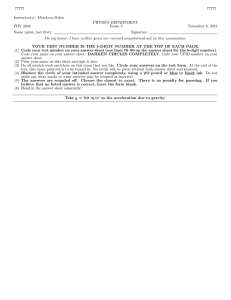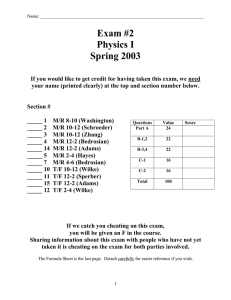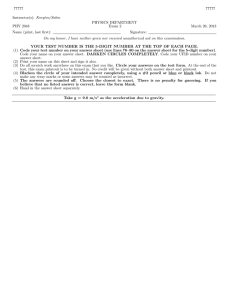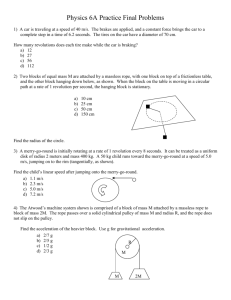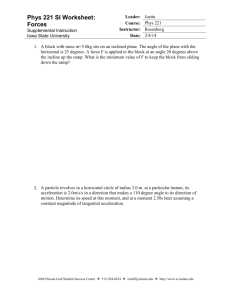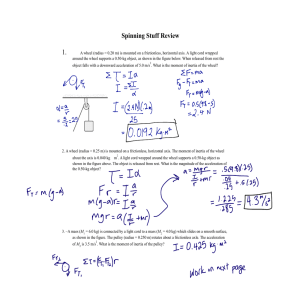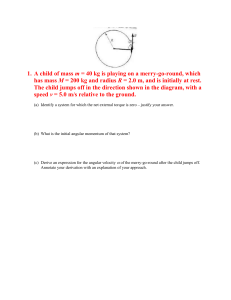77777 A. Hebard/J. Klauder PHYSICS DEPARTMENT PHY 2048
advertisement
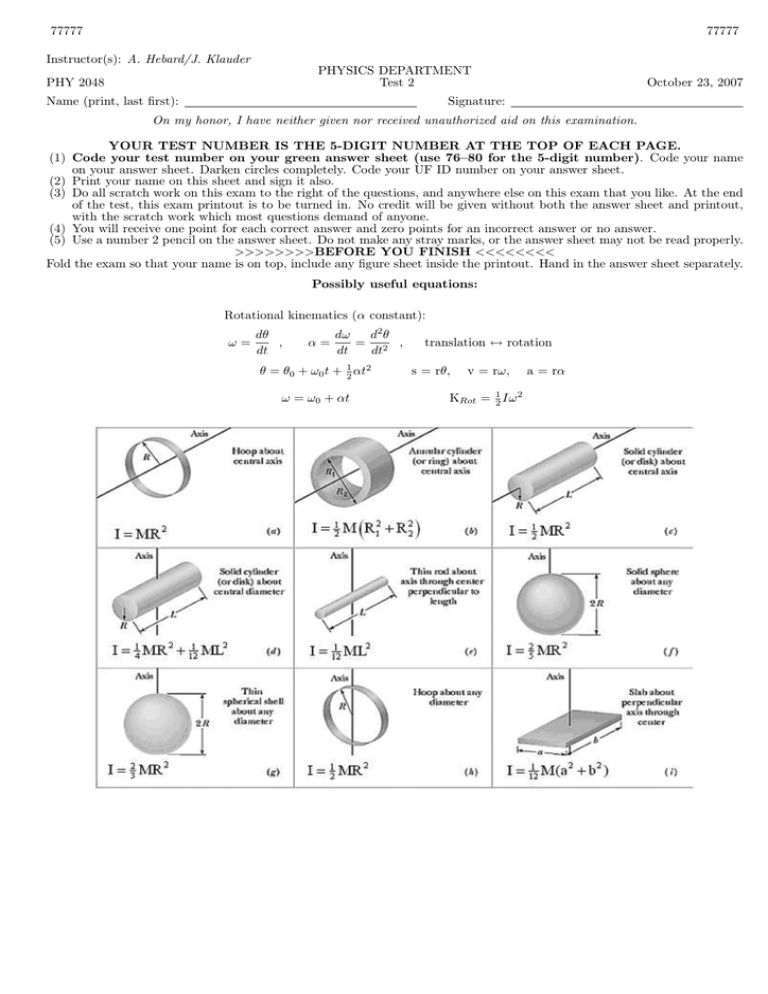
77777 77777 Instructor(s): A. Hebard/J. Klauder PHYSICS DEPARTMENT Test 2 PHY 2048 Name (print, last first): October 23, 2007 Signature: On my honor, I have neither given nor received unauthorized aid on this examination. YOUR TEST NUMBER IS THE 5-DIGIT NUMBER AT THE TOP OF EACH PAGE. (1) Code your test number on your green answer sheet (use 76–80 for the 5-digit number). Code your name on your answer sheet. Darken circles completely. Code your UF ID number on your answer sheet. (2) Print your name on this sheet and sign it also. (3) Do all scratch work on this exam to the right of the questions, and anywhere else on this exam that you like. At the end of the test, this exam printout is to be turned in. No credit will be given without both the answer sheet and printout, with the scratch work which most questions demand of anyone. (4) You will receive one point for each correct answer and zero points for an incorrect answer or no answer. (5) Use a number 2 pencil on the answer sheet. Do not make any stray marks, or the answer sheet may not be read properly. >>>>>>>>BEFORE YOU FINISH <<<<<<<< Fold the exam so that your name is on top, include any figure sheet inside the printout. Hand in the answer sheet separately. Possibly useful equations: Rotational kinematics (α constant): ω= dθ , dt α= dω d2 θ = 2 , dt dt θ = θ0 + ω0 t + 12 αt2 ω = ω0 + αt translation ↔ rotation s = rθ, v = rω, KRot = 21 Iω 2 a = rα 77777 77777 1. One end of a 1.0-m long string is fixed, the other end is attached to a 2.0-kg stone. The stone swings in a vertical circle, passing the bottom point at 4.0m/s. The tension force of the string at this point is about: (1) 52N (2) 12N (3) 20N (4) 32N (5) 0 2. An automobile moves on a level horizontal road in a circle of radius 30m. The coefficient of friction between tires and road is 0.50. The maximum speed with which this car can round this curve is: (1) 12m/s (2) 4.9m/s (3) 9.8m/s (4) 3.0m/s (5) 13m/s 3. An object is constrained by a cord to move in a circular path of radius 0.5m on a horizontal frictionless surface. The cord will break if its tension exceeds 16N. The maximum kinetic energy the object can have is: (1) 4 J (2) 8 J (3) 16 J (4) 32 J (5) 64 J 4. A boy holds a 40-N weight at arm’s length for 10 s. His arm is 1.5m above the ground. The work done by the force of the boy on the weight while he is holding it is: (1) 0 (2) 6.1 J (3) 40 J (4) 60 J (5) 90 J 5. Camping equipment weighing 6000N is pulled across a frozen lake by means of a horizontal rope. The coefficient of kinetic friction is 0.05. The work done by the campers in pulling the equipment 1000m at constant velocity is: (1) 3.0 × 105 J (2) 1.5 × 105 J (3) 3.1 × 104 J (4) 2.9 × 106 J (5) 6.0 × 106 J 6. A man pushes an 80-N crate a distance of 5.0m upward along a frictionless slope that makes an angle of 30◦ with the horizontal. The force he exerts is parallel to the slope. If the speed of the crate is constant, then the work done by the man is: (1) 200 J (2) 61 J (3) 140 J (4) −200 J (5) 260 J 7. A 6.0-kg block is released from rest 80m above the ground. When it has fallen 60m its kinetic energy is approximately: (1) 3500 J (2) 4800 J (3) 1200 J (4) 120 J (5) 60 J 8. An elevator is rising at constant speed. Consider the following statements: I. the upward cable force is constant II. the kinetic energy of the elevator is constant III. the gravitational potential energy of the Earth- elevator system is constant IV. the acceleration of the elevator is zero V. the mechanical energy of the Earth-elevator system is constant (1) (2) (3) (4) (5) only I, II, and IV are true only II and V are true only IV and V are true only I, II, and III are true all five are true 9. A 0.50-kg block attached to an ideal spring with a spring constant of 80N/m oscillates on a horizontal frictionless surface. When the spring is 4.0 cm longer than its equilibrium length, the speed of the block is 0.50m/s. The greatest speed of the block is: (1) 0.71m/s (2) 0.32m/s (3) 0.55m/s (4) 0.23m/s (5) 0.93m/s 77777 77777 10. A 700-N man jumps out of a window into a fire net 10m below. The net stretches 2m before bringing the man to rest and tossing him back into the air. The maximum potential energy of the net, compared to its unstretched potential energy, is: (1) 8400 J (2) 710 J (3) 850 J (4) 7000 J (5) 300 J 11. A small object of mass m starts from rest at the position shown and slides along the frictionless loop-the-loop track of radius R. What is the smallest value of y such that the object will slide without losing contact with the track? (1) R/2 (2) R/4 (3) R (4) 2R (5) zero 12. Two boys, with masses of 40 kg and 60 kg, respectively, stand on a horizontal frictionless surface holding the ends of a light 10-m long rod. The boys pull themselves together along the rod. When they meet the 60-kg boy will have moved what distance? (1) 4m (2) 5m (3) 6m (4) 10m (5) need to know the forces they exert 13. A 1.0-kg ball moving at 2.0m/s perpendicular to a wall rebounds from the wall at 1.5m/s. The change in the momentum of the ball is: (1) 3.5N·s away from wall (2) 0.5N·s away from wall (3) 0.5N·s toward wall (4) zero (5) 3.5N·s toward wall 14. Two spacemen are floating together with zero speed in a gravity-free region of space. The mass of spaceman A is 120 kg and that of spaceman B is 90 kg. Spaceman A pushes B away from him with B attaining a final speed of 0.5m/s. The final recoil speed of A is: (1) 0.38m/s (2) zero (3) 0.5m/s (4) 0.67m/s (5) 1.0m/s 15. A merry-go-round rotates from rest with an angular acceleration of 2.0 rad/s2 . It takes about 3.5 s to rotate the first two 2 revolutions. About how much time does it take to rotate the next 2 revolutions? (1) 1.5 s (2) 0.5 s (3) 2.0 s (4) 2.5 s (5) 3.5 s 16. Four identical particles, each with mass m, are arranged in the x,y plane as shown. They are connected by light (treat as massless) sticks to form a rigid body. If m = 2.0kg and a = 1.0m, the rotational inertia of this array about the y axis is: (1) 12 kg·m2 (2) 4.0kg·m2 (3) 9.6kg·m2 (4) 4.8kg·m2 (5) none of these 17. A and B are two solid cylinders made of aluminum. Their dimensions are shown (Hint: note different radii and lengths). The ratio of the rotational inertia of B to that of A about the common axis is: (1) 32 (2) 4 (3) 8 (4) 16 (5) 2 77777 77777 18. A disk has a rotational inertia of 6.0kg m2 and a constant angular acceleration of 2.0 rad/s2 . If it starts from rest the work done during the first 5.0 s by the net torque acting on it is: (1) 300 J (2) 30 J (3) 60 J (4) 0 (5) 600 J 19. A playground merry-go-round has a radius R and a rotational inertia I. When the merry-go-round is at rest, a child with mass m runs with speed v along a line tangent to the rim and jumps on. The angular velocity of the merry-go-round is then: (1) mRv/(mR2 + I) (2) v/R (3) mRv/I (4) 2mRvI (5) mv/I 20. When a woman on a frictionless rotating turntable extends her arms out horizontally, her angular momentum: (1) (2) (3) (4) (5) must remain the same must decrease must increase may increase or decrease depending on her initial angular velocity tilts away from the vertical
